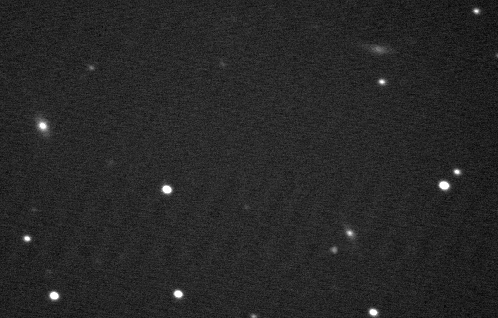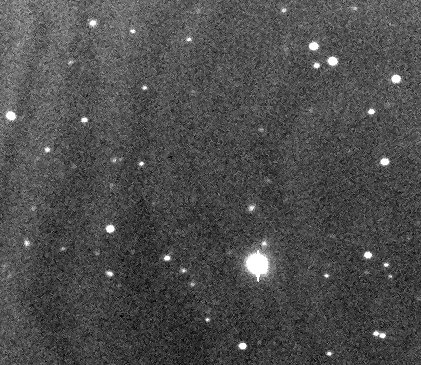Prairie Grass Observatory is an official asteroid discovery/tracking station. With the recent concern about the possibility of an asteroid colliding with the earth, there are now large professional "surveys" being done to try to find and catalog as many asteroids as possible. It takes a few years of regular monitoring of an asteroid's position to accuartely determine its orbit. The surveys, however, are set up to use pre-arranged search patterns to try to find new asteroids. While follow-up observations of most newly discovered asteroids will result as a side benefit of the survey's searches, in many cases deliberate follow-up is needed. For example, if a (relatively speaking) small asteroid is first discovered while passing very close to earth, it may quickly become too dim for observation as it moves away, so immediate follow-up is needed, so that its orbit can be determined at least well enough to have a good chance of being able to find it the next time it gets near earth, so further positional measurements can be made to refine its orbit. In other cases, a newly discovered asteroid may simply slip through the net of further follow-up via the surveys. In both cases, much of the the follow-up is done by several smaller professional observatories and many amateurs.
One of the most interesting objects tracked at PGO occurred right at the start. As I was preparing a first "test batch" of measurements, Bill Yeung, one of the world's most accomplished amateur asteroid hunters, sent word out via the Minor Planet Mailing List (an internet email list for asteroid hunters) that he had detected an odd object. After a few nights of observations, the MPC determined that this object was orbiting the earth, and took it off their lists, assuming it was space junk. But then satellite experts determined that this object, dubbed J002E3, could not be matched to any known man made object. At this point NASA got interested and added it to their list of solar system objects. One obvious question was why hadn't the object been detected previously? It was relatively bright compared to most asteroids discovered in the last few years, so if it had been in orbit around the earth for any period of time it should have been detected by the current asteroid surveys several times already.
The only answer was that it had only recently entered earth's orbit. Over the next several days, dozens of measurements from many observatories, including PGO, allowed NASA to determine the object's path accurately enough to extrapolate backwards a few months in an attempt to find out where it had come from. The object was in a very high orbit, sometimes further than the moon, and since the moon is a significant fraction of the earth's mass, its gravity also has a significant effect on the orbit of any object orbiting that far out, so the orbit was somewhat unstable. NASA found that the object had only orbited a few times and before that had come from near a point in space known as the L1 Lagrange point (Lagrange was an 18th century French mathematician who first determined the position of the "Lagrange points"). Orbits occur because the centrifugal force from the curved orbital path balances the gravity from whatever an object is orbiting around, and Lagrange points are places near the earth's orbit where the earth's gravity combines with the sun's to allow an object to orbit the sun at the same rate as the earth, even though the distance to the sun from that point is not the same as the distance from the earth to the sun. In this case the L1 Lagrange point is on a line between the earth and the sun, about 1 million miles closer to the sun than the earth is. Here the sun's gravity is stronger than at the earth, so an object would normally have to orbit faster so that the centrifugal force on the object will be stronger, but since an object at that point will have the gravity of the earth pulling opposite the sun's gravity, the gravity will be partly cancelled and the object can orbit slower, at a rate that matches the earth's orbit. Lagrange points are common "transition points" between an orbit around the sun and an orbit around a planet. Several of Jupiter's smaller moons are thought to have been pulled in from (Jupiter's) Lagrange points.
At this point NASA could not reliably estimate where the object had been any earlier, but another few weeks of observations allowed increased accuracy of the backward projections, and NASA found that before the object was pulled in from the L1 point, it had orbited the sun not exactly at the L1 point, but had been orbiting the sun just slightly closer to the sun than the earth and slightly faster than the earth, and had "lapped" the earth every 15 years. The projection showed that 15 years ago, the last time the object was near earth, it did not get near the L1 point, but that 15 years before that, it had. Just as objects can get pulled in from the L1 point, they can also leave that way, so it was possible that this object was a lost spacecraft, but which one?
A final piece of evidence proves that J002E3 is man-made: A very large observatory telescope was aimed at J002E3 to obtain spectrographic data. The evidence showed considerable amounts of titanium oxide (TiO). TiO has a definite significance in astronomy- most molecules will break down into individual atoms if they're in the atmosphere of a star, but TiO is one of the most heat-resistant molecules known, so it is one of the most frequently detected molecules in the atmospheres of stars (only small cool stars, others have no molecules at all). But in this case TiO was significant for another reason: it is also an extremely white material, and is one of the most common pigments in white paint, including the paint NASA used to paint the huge Saturn V rockets used in the Apollo missions.
That question turned out to be easy to answer. First, from the brightness it was clear that this was a sizable object, not a typical small satellite. When the Apollo missions went to the moon, a large upper stage was used to boost the craft from a low earth orbit to the moon. These would eventually separate from the rest of the craft and be sent into orbit around the sun. (Actually, after the Apollo 11 and 12 astronauts put seismographs on the moon, the later upper stages were deliberately crashed into the moon- an impact from a known object of a known mass and speed made a good test for calibrating the seismographs). But on Apollo 12 there was a glitch that left the upper stage in a very high earth orbit, about as far away as the moon. It was tracked for awhile, but was soon lost. Again the moon's gravity would have affected the orbit, so it is likely that the moon eventually flung the Apollo 12 upper stage to the L1 point and into solar orbit. So our mystery object appears to be the long lost upper stage from the second manned moon landing.



